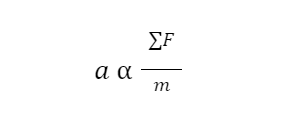Newton’s Laws of Motion

You’ve probably heard the story of Sir Isaac Newton and the apple falling on his head.
Whether this is a true story or not, we all know that Newton’s discoveries changed the field of Physics forever.
Newton is also credited for the discovery of many principles that can describe things that happen in our everyday lives. These include the laws of motion.
Newton developed his laws of motion after years of studying mathematics and science and published these findings in his famous book called “Principia Mathematica Philosophiae Naturalis,” where he explained how outside forces influence the movement of objects.
As Newton developed the laws of motion, he concentrated on effects that can be fully demonstrated in terms of mass, length, and time and neglected other variables such as air resistance, friction, and material properties.
We will address the three laws of motion with this reviewer.
Click below to go to the main reviewers:
Table of Contents
Law of Inertia
Did you know that when you throw a ball into outer space, it will continue to move indefinitely with the same velocity it had the moment the ball left your hand?
But if you throw a ball here on Earth, the ball will eventually stop. Why is that?
This happens because of Newton’s first law of motion!
Newton’s first law, the law of inertia, states that an object at rest tends to remain at rest and an object in motion tends to stay in motion unless acted upon by an external net force.
Simply put, an object will continue to do whatever it does unless a force is exerted on it.
The first part of the law makes sense because an object at rest typically does not start moving on its own. The ball in your palm will not move unless you move it, right?
The second part, however, seems confusing since it contradicts some of our daily experiences. When you throw a ball on Earth, it will not continue moving forever, right?
To understand the first law, we must examine all the forces acting on a body in motion.
On Earth, some forces impede motion, such as air resistance and friction. These forces slow us down, which is why a constant force must be applied to keep moving.
Let us take an ice-skating rink as an example. If you push a hockey puck, it will glide farther than it would if you glide it on the ground because the ice has little friction. Now, imagine if you glide a hockey puck on a frictionless surface. The hockey puck will continue moving with whatever velocity it has after leaving the stick unless a force acts on it.
This simple demonstration is exactly how objects move in space. Celestial bodies move at a constant velocity and never stop moving.
Comparing the motion in space with the motion on Earth, we should note that the motion in space is the normal motion and the motion on Earth is a special case.
The ability of an object to resist changes in motion is called inertia. Force must be applied to keep an object moving and to make it stop moving. Motion with constant velocity, as in the case of celestial bodies, does not require force.
Any object has an amount of inertia that is proportional to its mass. The bigger the object is, the greater its inertia.
For example, let us compare a golf ball and a bowling ball. When you flick a golf ball, it will move easily until it stops. A bowling ball, however, requires more force to move and stop.

Based on our example, we can say that mass is a measurement of an object’s inertia.
Let us assume you have a car accident. The force of impact can stop the vehicle, but the inertia ensures that your body can keep going. We wear seatbelts because we could continue flying through the windshield if we do not.
The net force is the sum of the forces acting upon the object. If the net force is not zero, there will be some motion. If the net force is zero, there will be no motion.
Law of Acceleration
Have you ever wondered why it is so hard to move a heavy object such as a large stone boulder compared to a small object like a pebble?
Well, that is because of Newton’s law of acceleration!
We learned in the first law that an object will continue its state of motion unless acted upon by some external net force. From this concept, the second law is continued with its focus on the net force that acts upon the object.
The second law of motion, also known as the law of acceleration, states that the acceleration of an object is directly proportional to the net force acting on the object, is in the direction of the net force, and is inversely proportional to the mass of the object.
Mathematically,

It is simply known as F = ma.
We can see many things from this equation.
First, the heavier the object, the greater the force you must apply to cause acceleration. Conversely, the lighter the object, the less force it takes to accelerate.

Therefore, moving lighter objects is simpler than moving heavier ones.
It is also important to understand that the net force refers to the sum of all the forces acting on an object. If there are multiple forces, we must represent this using a free body diagram and then use vector addition. This will tell us the direction of the acceleration that will occur in response to the net force.
Mass vs. Weight
While mass is the measurement of an object’s inertia, weight is the gravitational force that the earth exerts on the object.
These two words, since they are closely related, are frequently interchanged.
When an object is massive, it also has a large weight. Say, a bowling ball, for instance. A bowling bowl is hard to throw because it is massive and hard to lift at the same time because of its large weight.
Weight can be obtained when the acceleration is equal to the acceleration due to gravity. It is the force that makes an object accelerate downward. Mathematically, w =mg.
Law of Interaction
Remember how much it hurts when you hit a mosquito landing on your legs using your hand? Why does your hand hurt as well?
Have you ever heard of the statement, “For every action, there is an equal and opposite reaction”?
Well, that is because of the third law of motion!
Though many people metaphorically predict this statement, it is interpreted differently in physics. This means that if two objects interact, the forces they exert on each other will be equal in magnitude but opposite in terms of direction.
Take a book sitting on your table for an example. Your book exerts a force on your table, and the table exerts a force back on your book. These forces are equal in magnitude but opposite in direction, which explains why the book is not moving.
This law also implies that forces must come in pairs (action-reaction) since any force is an interaction. Mathematically,

This may be confusing because many forces are acting on an object. However, we should learn how to isolate systems.
When we assess the motion of an object, we only consider the force acting on it, not the forces it applies to another object.
Let us analyze a nail being hammered into a wall. The hammer exerts a force on the nail when you hammer it into the wall, and the nail exerts a force back to the hammer.

The net force acting on the nail from the hammer’s motion, however, makes the nail go into the wall. The hammer also has two forces acting upon it – one is the downward force from your arm, and the other is the upward force from the nail.
Seems confusing right?
Always remember that when you look for the forces, you look at one object at a time and figure out the force-reaction pair.
Next topic: Friction
Previous topic: Relative Velocity
Return to the main article: The Ultimate Physics Reviewer
Download Article in PDF Format
Test Yourself!
1. Practice Questions [PDF Download]
2. Answer Key [PDF Download]
Written by Mary Joy Montenegro
Mary Joy Montenegro
Mary Joy Montenegro is a licensed professional teacher who obtained her Master’s Degree in Teaching Physics at De La Salle University under the Department of Science and Technology Scholarship. Aside from teaching, she also loves traveling and meeting other people.
Copyright Notice
All materials contained on this site are protected by the Republic of the Philippines copyright law and may not be reproduced, distributed, transmitted, displayed, published, or broadcast without the prior written permission of filipiknow.net or in the case of third party materials, the owner of that content. You may not alter or remove any trademark, copyright, or other notice from copies of the content. Be warned that we have already reported and helped terminate several websites and YouTube channels for blatantly stealing our content. If you wish to use filipiknow.net content for commercial purposes, such as for content syndication, etc., please contact us at legal(at)filipiknow(dot)net